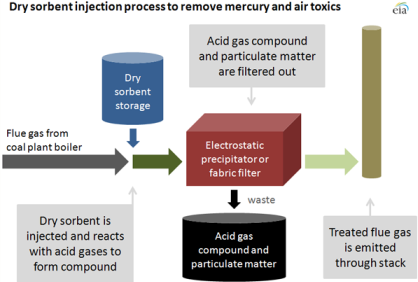March 16, 2012
Dry sorbent injection may serve as a key pollution control technology at power plants

Source: U.S. Energy Information Administration.
Dry sorbent injection (DSI) is a pollution control technology that may play a role in the United States' electric power sector's compliance with the Mercury and Air Toxics Standards (MATS). The Environmental Protection Agency (EPA) finalized the MATS rule in December 2011. The MATS rule requires that all U.S. coal- and oil-fired power plants greater than 25 megawatts meet emission limits consistent with the average performance of the top 12% of existing units —known as the maximum achievable control technology (MACT). The rule applies to three pollutants: mercury (Hg), hydrochloric acid (HCl), and filterable particulate matter (fPM) and has a compliance deadline in 2015 (with opportunities for additional compliance time depending upon case-by-case circumstances). While DSI systems do not control for mercury, they can, when combined with a particulate control filter, meet this standard for two of the three controlled pollutants.
DSI systems remove hydrogen chloride (HCl) and other acid gases through two basic steps.
- Step one. A powdered sorbent is injected into the flue gas—combustion exhaust gas exiting a power plant—where it reacts with the HCl. The sorbents most commonly associated with DSI are trona (sodium sesquicarbonate, a naturally occurring mineral mined in Wyoming), sodium bicarbonate, and hydrated lime.
- Step two. The compound is removed by a downstream particulate matter control device such as an electrostatic precipitator (ESP) or a fabric filter (FF), also referred to as a baghouse. Fabric filters are generally more effective (when combined with DSI) than ESPs, with respect to overall HCl reduction. For modeling purposes, EPA estimates a DSI system with a fabric filter is expected to achieve 90% removal of HCl, while an ESP only achieves 60% removal, although actual performance will vary by individual plant.
DSI systems can also significantly reduce sulfur dioxide (SO2) emissions through the same process as HCl removal. While the MATS rule does not specifically address SO2, it has similar qualities to HCl and other acid gases that enable it to respond similarly in a DSI system. SO2 is also regulated under the Cross State Air Pollution Rule (CSAPR). Therefore, installing a DSI or FGD system to comply with MATS may also help plants meet or even exceed their CSAPR emission limits.
While compliance with the MATS rule was not assumed in the Annual Energy Outlook 2012 (AEO2012) Early Release, it will be assumed in the AEO2012 full Reference case (to be released in Spring 2012), and DSI will be included as a compliance option for coal power plants.
No comments:
Post a Comment
Note: Only a member of this blog may post a comment.